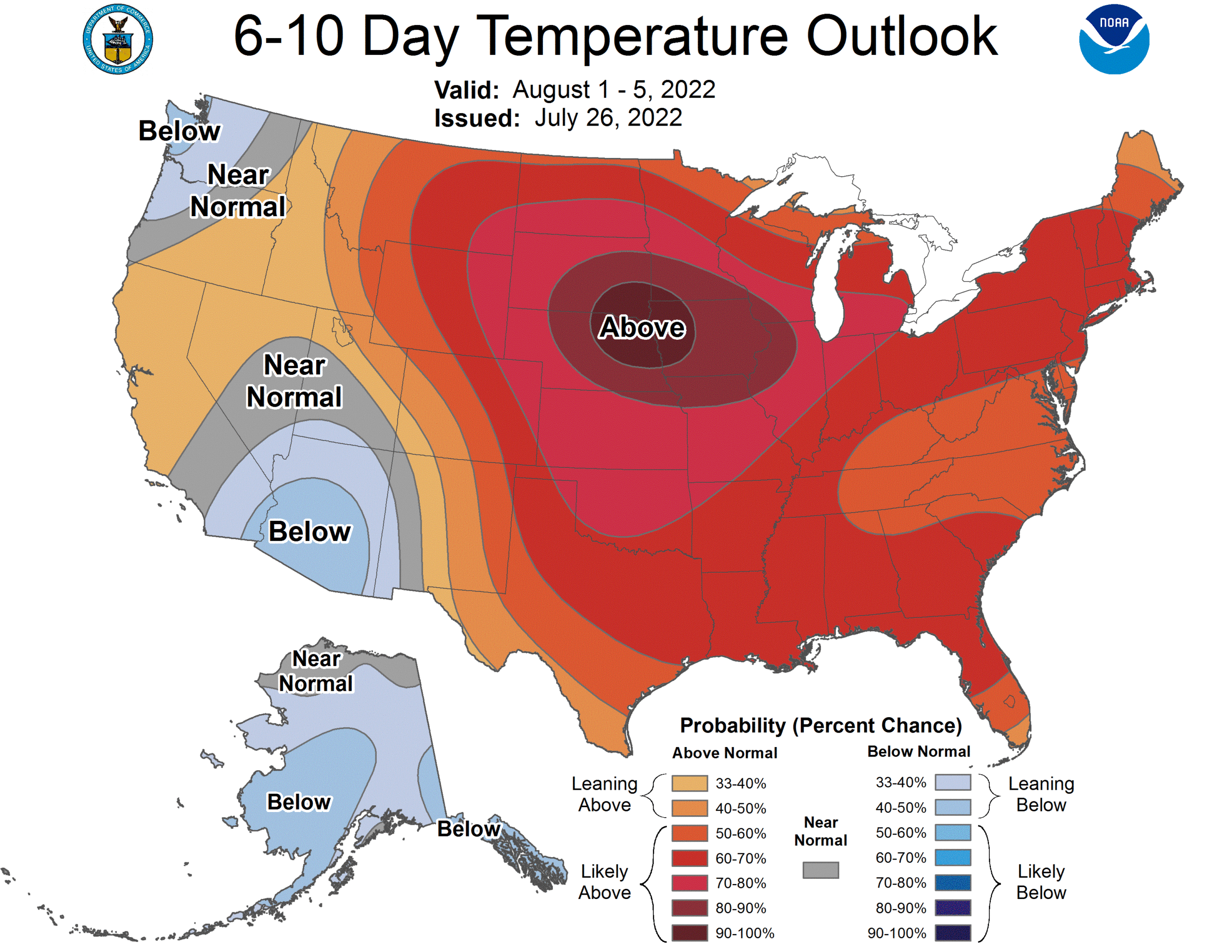PDF Attached
FOMC
Hikes By 75Bps; Target Range Stands At 2.25% – 2.50%
FOMC
Interest Rate On Reserves Balances Raised To 2.40% From 1.65%
Fed
Raises Main Rate In Unanimous Vote, Ongoing Hikes Likely To Be Appropriate
US
Interest Rate Futures See Fed Funds Rate 3.4% In December After 75Bps Hike
–
See 107Bps Of Tightening For Rest Of 2022
The
US morning and midday weather outlook appeared to be mostly unchanged. Ridging is still a strong possibility for the Midwest next week. The Midwest will see rain favoring the southern areas through Saturday and north central areas today. The Great Plains will
see rain across NE and northern KS through today and far western GP Thursday through Saturday.
US
equities rallied post FED rate announcement and short speech thereafter. US corn traded mixed, ending higher. Wheat sold off on technical selling while the soybean complex rallied on US weather concerns and ideas US meal export demand could increase due to
lack of global meal shortages.
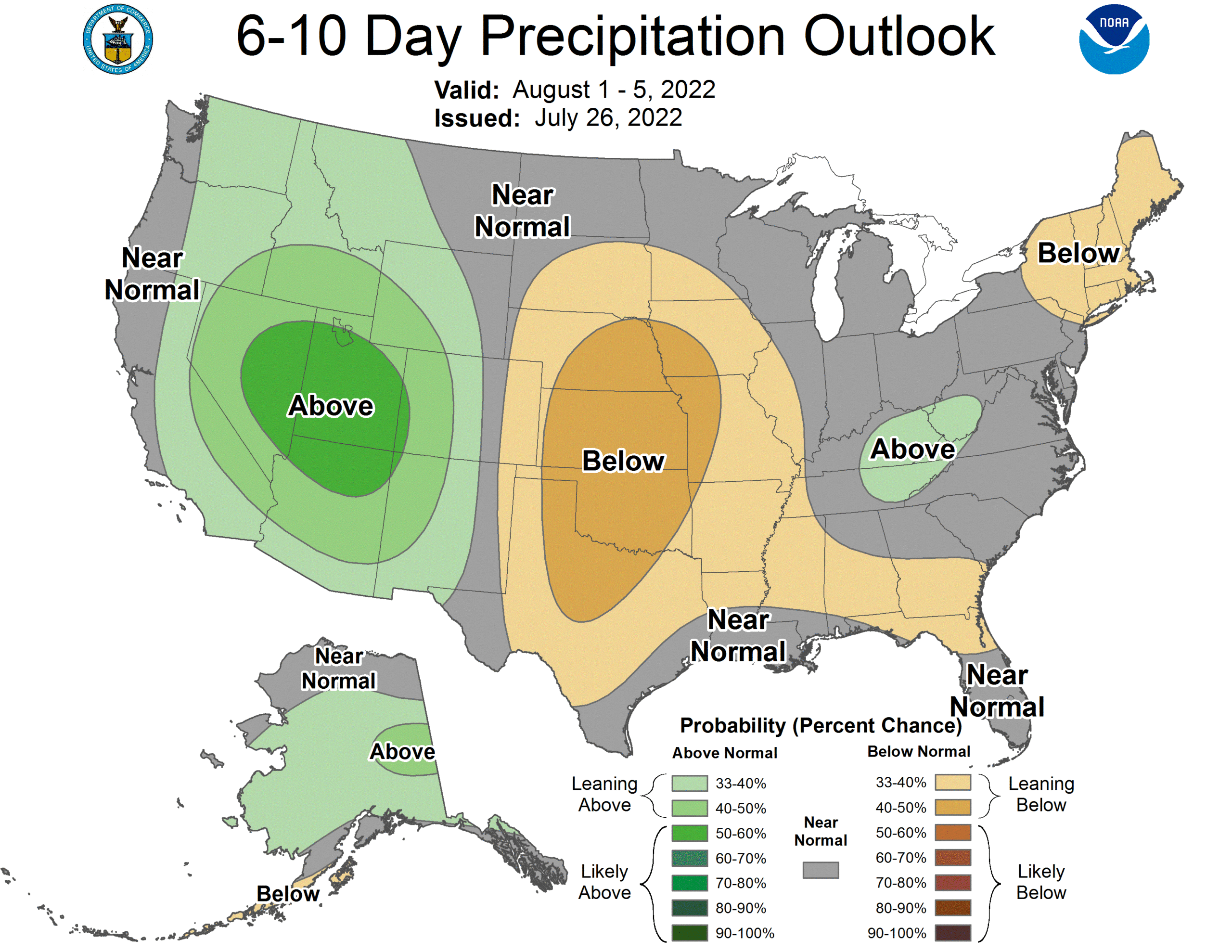
World
Weather Inc.
WEATHER
TO WATCH AROUND THE WORLD
-
Northwestern
U.S. Corn and Soybean Belt already trending too dry -
The
latest soil assessment shows an expansion of dryness from Nebraska and South Dakota into southern Minnesota and western Iowa -
The
poorest soil conditions are in northeastern Nebraska, northwestern Iowa, southeastern South Dakota and southern Minnesota
-
Soil
conditions have improved from this week’s rain from eastern Kansas into southwestern Illinois and
-
Rain
is expected to continue into the weekend from southern Kansas, Oklahoma and the northern Texas Panhandle into the U.S. Delta and Kentucky with a few areas in the Ohio River Valley to be included -
Net
drying is advertised in other areas in the Midwest, but temperatures will be mild during much of this period of time keeping the drying rates slow. Crop conditions should remain favorable outside of the northwestern Corn and Soybean Belt -
Hotter
conditions will reach the Great Plains late this weekend before intensifying and advancing from west to east across the Midwest during the week next week -
The
heat will not be preceded by much significant rain suggesting the northwestern U.S. Corn and Soybean Belt will be facing some very stressful conditions next week unless greater rain evolves than advertised and that is not very likely -
Warming
across most of the U.S. Midwest along with restricted rainfall next week and into the following weekend will accelerate drying rates
-
Much
of the Midwest will have favorable soil moisture initially to help limit the impact of hotter and drier weather, but temperatures in the 90s Fahrenheit will be sufficient to accelerate drying rates -
Extreme
highs over 100 will impact the Plains next week with the northern and central Plains and western Corn Belt in the midst of the hottest conditions during mid- to late week next week
-
Crop
stress in the Midwest outside of the northwestern Corn and Soybean Belt will evolve in the week 2 period (August 3-9) period, but the most threatening period of potential stress would come in the August 10-17 period “IF” the drier and warmer weather pattern
prevails -
Northwestern
Corn and Soybean areas will see stress immediately since soil conditions are already quite dry -
The
bulk of Texas will continue in a dry and warm to hot mode for much of the coming week to nearly ten days -
There
is potential that rain may evolve in Texas while the high pressure ridge attempts to move into the eastern Midwest during the August 5-10 period -
Confidence
in this eastward shift in the ridge is low and therefore so is the rain potential in Texas; however, in August rainfall potential should improve for the Texas coast, South Texas and neighboring northeastern Mexico
-
Excessive
heat continues to improve the Pacific Northwest and this pattern will prevail through the weekend -
Extreme
highs reached 111 degrees at The Dalles, Oregon -
Other
highs in the Pacific Northwest were in the 90s to 106 Fahrenheit -
Southern
British Columbia reported extreme highs to 104 -
Some
relief is expected after the weekend, although warmer than usual conditions may continue for a little while longer -
Temperatures
should become more seasonable during the second week of the outlook -
Increased
monsoonal rainfall is possible in the southwestern United States next week and into the following weekend – especially if the North America high pressure ridge briefly shifts farther to the east -
World
Weather, Inc. believes the U.S. high pressure ridge may briefly reach into the heart of the Midwest late next week and into the following weekend, but the odds are high that the ridge will retrograde to the west in the following week allowing some cooling
in the eastern Midwest, but keeping the Plains and western Midwest quite warm and drier biased -
Much
of Europe rainfall will be restricted over the next ten days while temperatures are near to above normal
-
Net
drying is expected in the majority of the continent, but especially in France, the U.K., Belgium, Netherlands, Germany, Spain, Portugal and from the lower Danube River Basin to Hungary -
Eastern
Europe will receive rain this weekend into early next week from Czech Republic and Austria to Belarus and northwestern Ukraine with rainfall of 1.00 to 2.00 inches and locally more resulting -
Net
drying will persist for the next couple of weeks from Hungary into Greece resulting in more threatening crop heat and moisture stress -
A
mostly good mix of weather will occur in the Commonwealth of Independent States through the next two weeks
-
Concern
remains over erratic rainfall in Russia’s Southern Region, southeastern Ukraine and parts of Kazakhstan -
Rain
is expected in Russia’s Southern region and temperatures will be mild enough to conserve the resulting rainfall through lower evaporation rates -
A
boost in rainfall is advertised for western, central and northern Ukraine after the end of this week and the moisture increase will bring on better crop and field conditions -
Argentina
received some welcome rainfall Tuesday and early today in Buenos Aires and La Pampa -
Moisture
totals varied from 0.10 to 0.60 inch in central and southern Buenos Aires and La Pampa with local totals of 1.00 to 2.00 inches in western Buenos Aires -
The
greatest rain fell in east-central Buenos Aires where 2.00 to 4.39 inches resulted in several areas.
-
Wheat
and barley emergence and establishment will improve as a result of the rain.
-
Argentina
will see additional rain today and Thursday mostly in the south and east-central parts of the nation while the west-central and northwest stay a little too dry -
Far
southern Brazil will receive periodic rainfall during the next ten days maintaining a typically moist pattern in the soil from Rio Grande do Sul into Paraguay, southernmost Mato Grosso do Sul and parts of both Parana and southern Sao Paulo -
The
moisture will be great for winter crops and should not have much impact on Safrinha crop maturation or harvesting -
Safrinha
cotton and late corn harvesting in Brazil will advance well due to continued dry and warm weather -
There
is no threat of cold weather in Brazil coffee, citrus or sugarcane areas during the next two weeks -
Southeastern
Canada crop conditions are rated favorably with little change likely for a while -
Canada’s
southwestern and central Prairies will dry down over the next week to ten days and temperatures will slowly rise above normal.
-
Crop
stress will rise once again as soil moisture is slowly depleted -
The
greatest stress will eventually evolve in central, west-central, southwestern and south-central Saskatchewan and southeastern Alberta, but conditions will remain favorable through the weekend -
India’s
monsoonal rainfall is expected to continue widespread across the nation during the next two weeks with all areas impacted and most getting sufficient rain to bolster soil moisture and/or induce flooding -
Some
areas may become too wet, but the precipitation will occur with sufficient breaks to prevent serious flooding from occurring -
Nationwide
rainfall is still expected to be above normal at mid-August and serious relief should occur to the dry areas of Uttar Pradesh and Bihar which have not received nearly as much rain as usual so far this year. Cotton, groundnut and soybean areas of northwestern
India should experience mostly good weather for crop improvements after flooding rain earlier this month -
China’s
weather is still advertised to be drier than usual in the southeastern corner over the next five days, but rain is expected thereafter -
The
return of rain should benefit rice and other late season crops -
The
greatest rain is still a week away -
Timely
rainfall is expected in most other areas in the nation during the next two weeks maintaining moisture abundance and a mostly good crop development environment -
China’s
Xinjiang province continues to experience relatively good weather -
A
few showers and thunderstorms are expected, but most of the region will be dry with temperatures varying greatly over the week to ten days -
Some
cooling is expected in Argentina late this week into early next week -
Sumatra,
Indonesia rainfall has started to improve with a couple of central west coast locations reporting heavy rainfall Monday and early today -
Rain
-
All
other Southeast Asian nations will experience an abundance of rainfall during the next few weeks resulting in some flooding in the Philippines and the Maritime provinces -
Australia
weather in the coming ten days will be favorable for most winter crops -
Central
Queensland received rain Wednesday and Thursday favoring a boost in topsoil moisture for a part of winter crop country
-
Western
Australia will get most of the significant rain this coming week, but some rain will eventually reach the southeastern parts of the nation in time next week.
-
South
Korea rice areas are still dealing with drought, despite some rain that fell recently.
-
Some
additional showers are expected over the next couple of weeks, but a soaking rain will continue to elude the region -
Western
Pacific Ocean tropical activity is expected to increase greatly over the next two weeks with multiple storms possibly impacting China, Taiwan, Japan and the Korean Peninsula -
The
stormiest conditions are expected in the second week of the forecast -
There
are no tropical cyclones in the Atlantic Ocean, Caribbean Sea or Gulf of Mexico and none are expected during the next ten days -
Tropical
Storm Frank remained well off the southwest coast of Mexico today -
This
system is expected to become better organized and evolve into a hurricane, but its movement should be away from western North America
-
East-central
Africa rainfall this week will be greatest in central and western Ethiopia, but it will soon be increasing in Uganda and Kenya -
Tanzania
is normally dry at this time of year, and it should be that way for the next few of weeks -
West-central
Africa rainfall has been and will continue sufficient to support coffee, cocoa, sugarcane, rice and cotton development normally -
Some
greater rain would still be welcome in the drier areas of Ivory Coast -
Seasonal
rains are shifting northward leading to some drying in southern areas throughout west-central Africa -
Cotton
areas are expecting greater rainfall in the next couple of weeks -
South
Africa’s crop moisture situation is favorable for winter crop establishment, although some additional rain might be welcome -
Restricted
rainfall is expected for a while, but the crop is rated better than usual -
Central
America rainfall will continue to be abundant to excessive and drying is needed -
Mexico
rain will be most abundant in the west and southern parts of the nation -
Rain
in the Greater Antilles will occur periodically, but no excessive amounts are likely -
Today’s
Southern Oscillation Index was +7.33 and it will continue to drift a little lower over the next few days, but should gradually level out -
New
Zealand weather is expected to be well mixed over the next two weeks -
Temperatures
will be seasonable with a slight cooler bias
Source:
World Weather INC
Bloomberg
Ag Calendar
Wednesday,
July 27:
- EIA
weekly U.S. ethanol inventories, production, 10:30am - Earnings:
Bunge
Thursday,
July 28:
- USDA
weekly net-export sales for corn, soybeans, wheat, cotton, pork and beef, 8:30am - Buenos
Aires grains exchange weekly crop report - HOLIDAY:
Thailand
Friday,
July 29:
- Vietnam
July coffee, rice and rubber export data - FranceAgriMer
weekly update on crop conditions - ICE
Futures Europe weekly commitments of traders report - US
agricultural prices paid, received, 3pm - CFTC
commitments of traders weekly report on positions for various U.S. futures and options, 3:30pm - HOLIDAY:
Thailand
Source:
Bloomberg and FI
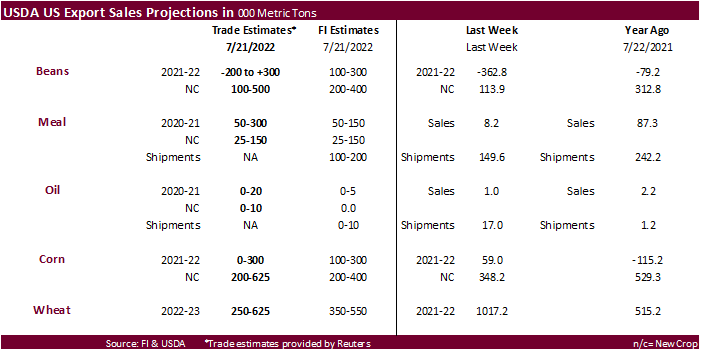
Macros
US
Durable Goods Orders Jun P: 1.9% (est -0.4%; prev 0.8%)
–
Durable Goods Ex Transportation Jun P: 0.3% (est 0.2%; prev 0.7%; prevR 0.5%)
–
Cap Goods Orders Nondef Ex Air Jun P: 0.5% (est 0.2%; prev 0.6%; prevR 0.5%)
–
Cap Goods Ship Nondef Ex Air Jun P: 0.7% (est 0.2%; prev 0.8%; prevR 1.0%)
US
Wholesale Inventories (M/M) Jun P: 1.9% (est 1.5%; prev 1.8%; prevR 1.9%)
US
Pending Home Sales (M/M) Jun: -8.6% (est -1.0%; prev R 0.4%)
–
Pending Home Sales NSA (Y/Y): -19.8% (est -13.5%; prev R -12.3%)
US
DoE Crude Oil Inventories (W/W) 22-Jul: -4.523M (est -1.037M; prev -0.445M)
–
Distillate Inventories: -0.784M (est +0.500M; prev -1.295M)
–
Cushing OK Crude: +0.751M (prev +1.143M)
–
Gasoline Inventories: -3.304M (est -0.857M; prev +3.498M)
–
Refinery Utilization: -1.5% (est +0.4%; prev -1.2%)
102
Counterparties Take $2.189 Tln At Fed Reverse Repo Op (prev $2.189 Tln, 98 Bids)
·
CBOT corn started higher on follow through buying from dryness across Europe and drier weather for the US through first week of August. Prices eventually eroded from a reversal in wheat to the downside but rebounded into the close
with September settling 3.25 cents higher and December 2.25 cents higher. Bull spreading was a feature all day.
·
Funds bought an estimated net 1,000 corn contracts.
·
Look for US weather to remain the driver for price influence.
·
South Africa’s CEC in their initial estimate of the 2022 corn crop was 14.713 million tons, down 10 percent from 16.315 million tons collected in 2021. White corn was seen at 7.470 million tons and 7.243 million tons for yellow
corn.
·
Bloomberg: Saudi Arabia is expected to increase its price for crude oil to a record differential for September.
US
weekly ethanol production
decreased 13,000 barrels from the previous week to 1.021 million and stocks decreased 225,000 barrels to 23.328 million. A Bloomberg poll looked for weekly US ethanol production to be down 2,000 barrels and stocks up 95,000 barrels to 23.648 million. Weekly
gasoline demand increased 724,000 barrels to 9.245 million.
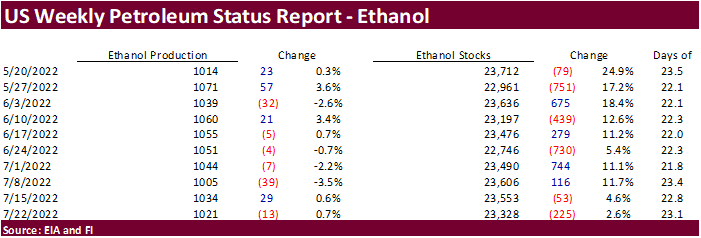
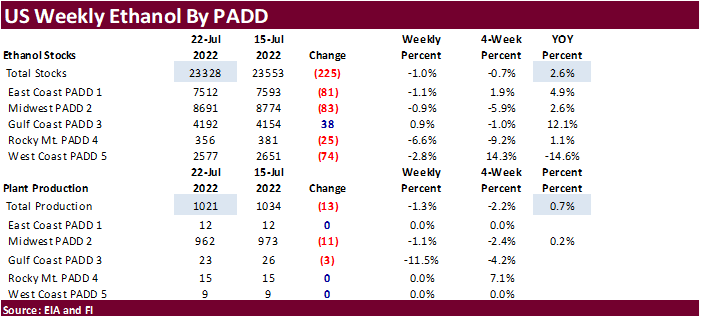
US
DoE Crude Oil Inventories (W/W) 22-Jul: -4.523M (est -1.037M; prev -0.445M)
–
Distillate Inventories: -0.784M (est +0.500M; prev -1.295M)
–
Cushing OK Crude: +0.751M (prev +1.143M)
–
Gasoline Inventories: -3.304M (est -0.857M; prev +3.498M)
–
Refinery Utilization: -1.5% (est +0.4%; prev -1.2%)
USDA
Attaché: Canada Grain and Feed Update
·
None reported
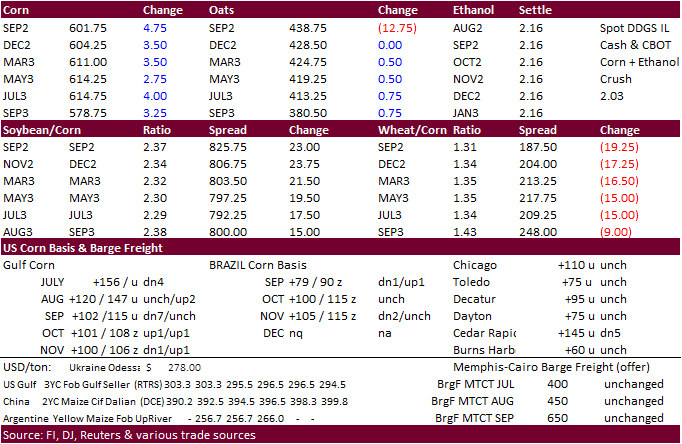
Updated
7/25/22
September
corn is seen in a $5.10 and $6.40 range
December
corn is seen in a $5.00-$7.50 range

